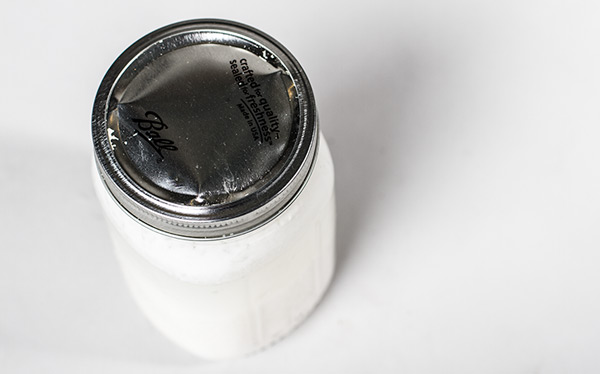Kefir is simple to make but it is also easy enough to mess up through curiosity. My latest experiment was to brew kefir like it was made long ago but I took way too many liberties to make this a worthy test.
The first kefir grains are believed to have formed inside of animal skin pouches. Originally, these pouches were used to carry fresh milk. At ambient temperatures, raw milk ferments on its own due to naturally occurring lactic acid bacteria. The animal skins were also presumably contributing bacteria to the milk. Eventually, polysaccharide matrices began to form on the inside of those pouches and the first kefir grains were born. This theory has been tested in a laboratory with positive results documented in this PDF journal article.
So with that idea in mind I extrapolated too far. I assumed that if kefir grains were forming on the inside of the animal skin pouches, then they must not have been washing those containers. Hence, the reason I decided to stop washing my kefir brewing vessel in-between straining and adding new milk.
I generally don’t wash my quart-sized kefir grain mason jar every day. I will usually wash it every few days or at least once a week. My kefir grains have been happy with this set-up for a few years.
For the last month or two I decided to stop washing the mason jar altogether. There was some buildup that began to form on the inside edges, but I believe this was milk fat solids and not polysaccharide matrices. What I should have been paying closer attention to was the lid.
Unlike yogurt, kefir likes to be jostled.
There is some disagreement on the best way to ferment kefir. Some ferment with a lid and others use a cloth or coffee filter for cover. Either way works but I prefer to use a lid so that I can give the jar a good shake any time that I pass by. This is similar to the way that kefir was traditionally hung by the entryways of homes in the Caucasus mountains and all visitors were required to kick the kefir bag when entering or leaving. Unlike yogurt, kefir likes to be jostled.
I believe the only reason the lid became an issue was because it was not remaining submerged in fresh milk, or kefir, and so the bacteria population of the lid was different than that in the kefir. By not washing the lid, eventually the lid bacteria made an attack on the fresh milk and kefir grains below. This may have been on ongoing battle and the kefir grains finally lost out.
...the kefir didn't taste horrible but it wasn't something I could confidently drink either.
On the day that my kefir grains died a sad death, the kefir didn’t taste horrible but it wasn’t something I could confidently drink either. Given that it tasted off and that the kefir had curdled but had not yet thickened gave me the impression that I had done something wrong.
I attempted another day of grain fermentation using fresh milk, but after 24 hours it had not thickened. I left the jar for one more night in the warmest place I could find and by morning the lid was dented outward from the build up of gas pressure inside.
This wasn’t the first time I had seen a dented lid. It had happened on two other occasions when I forgot to release gas buildup within mason jars when fermenting vegetables. This was, however, the first time that I had experienced this with a dairy ferment. Maybe my kefir grains weren’t completely dead, but the lactic acid bacteria were weak. The yeasts, however, seemed to be going strong and so the pressure that had been building up for over 36 hours needed some where to escape.
...most things seem to take the path of least resistance.
With the little I understand of physics, most things seem to take the path of least resistance. If the mason jar would have had a hairline fracture or other weak spot, the glass jar may have exploded instead of the lid. Luckily, my mason jars have held up well and I have not experienced broken glass. I have never known anyone directly that has had a mason jar explode either. That doesn’t mean it couldn’t happen, so please be more careful then I am with pressure and glass.
I would not have tried this lazy experiment if I were not certain I had backup kefir grains. I store extra grains in the refrigerator in milk. I have successfully awoken kefir grains that were sitting in the back of my refrigerator for over one year. I’m not certain that this is normal or if my current kefir grains are just extra tough. Ideally, I should have at least been switching out the milk they were sitting in while not using refrigerated grains.
The grains I revived from the refrigerator after this mishap were much fresher. I had refrigerated them previous to starting this experiment and so I am once again happily brewing my daily batch of dairy kefir.
Just take this lesson from me: don’t be lazy when fermenting kefir, and if you are, please at least wash the lid.


 Listen Now
Listen Now 
